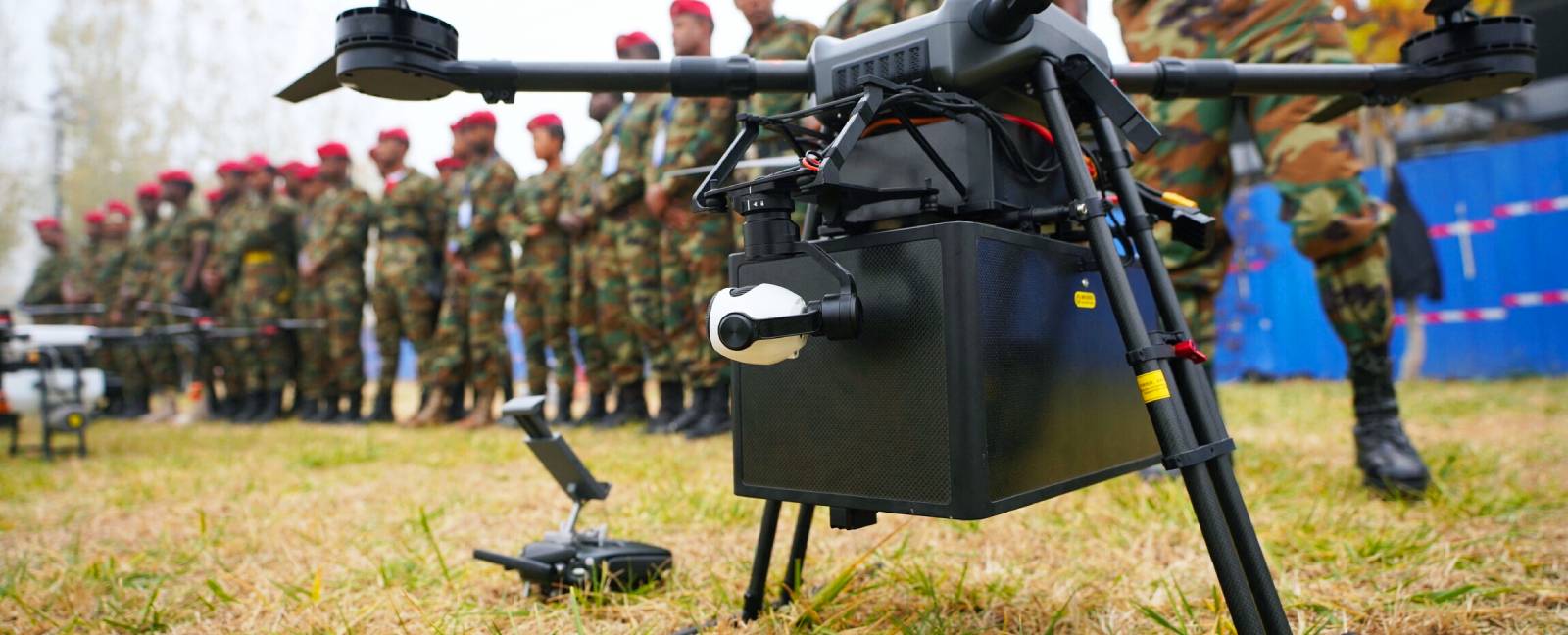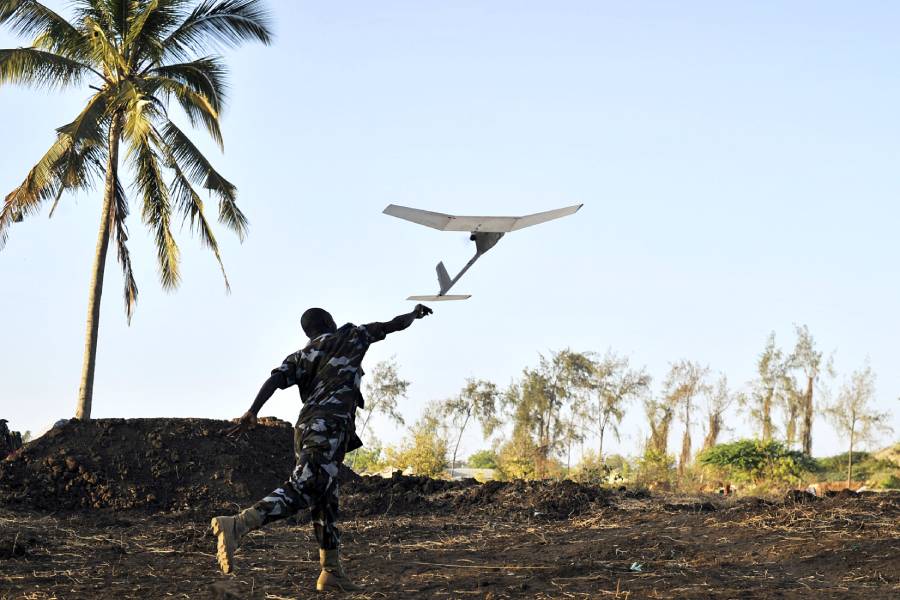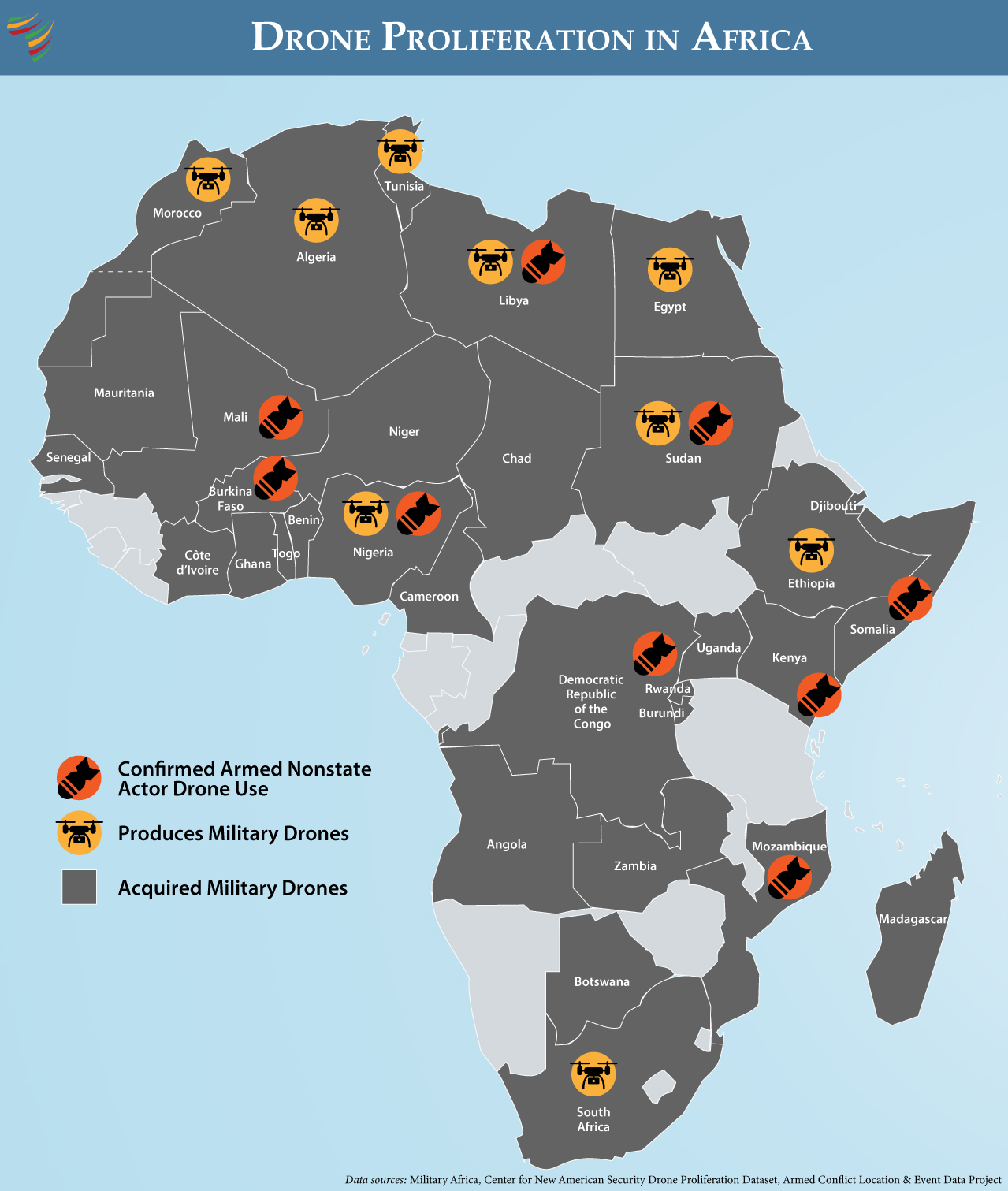
Ethiopian soldiers attend a drone piloting training program organized by the Chinese Ministry of Public Security at an aviation school in Beijing. (Photo: Xinhua via AFP/Xing Guangli)
General Abdel Fattah al-Burhan, leader of the Sudanese Armed Forces (SAF), survived a drone-launched assassination attempt at a military base in eastern Sudan on July 31, 2024. In a grainy video captured on a mobile phone, rows of young cadets can be seen marching in formation at an army graduation ceremony. An ominous buzzing sound overtakes festive drumbeats and bugle calls. It is followed by a loud bang as the first of two drones hits the base. The video then cuts to a triumphant Burhan vowing to continue the fight against the Rapid Support Forces (RSF), the SAF’s antagonist in Sudan’s devastating civil war.
African governments need to develop a more complex understanding of the risks and limitations of using armed drones.
From the skies above Khartoum to marketplaces in Mopti (Mali), hundreds of attacks employing drones have occurred across at least 15 countries in Africa in recent years. Propelled by falling costs, rapid technological advances, and the promise of precision air power, these systems are facilitating tactical advantages and territorial shifts. In response, African governments are rushing to incorporate unmanned systems and countermeasures into their arsenals.
Nevertheless, drones have not always proven to be the low-cost, low-risk tool of precision warfare they are perceived to be. As African policymakers and security practitioners grapple with the deployment, mitigation, and implications from the proliferation of unmanned systems, a balanced understanding of their benefits and risks will be needed.
Drone Proliferation Trends
With the global advancement and propagation of unmanned weapons systems, a new age of autonomous warfare has begun. In Ukraine, the world’s most advanced drone theater, drones caused 70 percent of battlefield injuries or deaths in 2024, supplanting artillery. World powers to small island states are now racing to acquire and employ unmanned systems. In Africa, four key trends are shaping contemporary drone warfare.
First is the increasing pace of military drone acquisition and use. Over the past two decades, at least 31 African countries have acquired thousands of individual unmanned units. The pace of government military drone acquisitions in Africa is increasing, with at least 15 bilateral acquisition agreements (with each agreement involving several to more than a dozen drones) every year since 2020. The proliferation of drones in Africa is being driven by a wide variety of factors, including low costs, growing availability, the desire for enhanced surveillance capacity, and the ability to project power against an exposed adversary at a low risk to the user.

A Ugandan soldier of the African Union Mission in Somalia launches a surveillance drone. (Photo: Tobin Jones/AFP)
The drones acquired include everything from small handheld drones that weigh less than a pound and used primarily for intelligence gathering to High-Altitude Long-Endurance (HALE) aircraft that can remain aloft for 24 hours, fly over 300 kilometers per hour, and drop 2,000-pound, precision-guided munitions. Popular models include Israel’s Bluebird Aero Systems WanderB vertical take-off and landing (VTOL) tactical surveillance drone, the U.S.-based BAE Systems Sky Eye surveillance drone, and the medium altitude high endurance (MALE) Turkish Bayraktar TB2, the single most popular combat drone in Africa.
The TB2’s acquisition and use by the Government of National Accord (GNA) proved decisive in defeating an offensive mounted by the rival Libyan National Army (LNA) during the battle for Tripoli in 2020, helping to spur the ongoing wave of drone proliferation across the world. The TB2s, combined with upgraded air defenses and sophisticated jamming gear, enabled the GNA to use combined arms maneuvers to retake and eventually push back the LNA from Tripoli and its environs.
Second, middle powers, particularly Türkiye, are asymmetrically expanding their influence in Africa by meeting the continent’s rising demand for drones. Türkiye is Africa’s top supplier, with a total of 32 agreements, 28 of which have occurred since 2021. Türkiye has succeeded by appealing to the desire of countries across Africa to acquire affordable, modern weapons outside the supply chains of major technological powers. Israel, the UAE, and Iran have similarly expanded their reach on the continent via the supply of drones.
On the demand side, Nigeria (18 acquisitions), Algeria (15), Ethiopia (12), and Morocco (11) are Africa’s top drone seekers.
Click here for a printable PDF.
Third, African countries are seeking to indigenize drone production capabilities, particularly with the proliferation of small, commercially-made drones that are being modified and integrated into tactical operations. Enterprises in nine African countries (Algeria, Egypt, Ethiopia, Kenya, Morocco, Nigeria, South Africa, Sudan, and Tunisia) now produce military drones, supplying approximately 12 percent of Africa’s overall drone market. South Africa, the continent’s longest-standing drone producer, has manufactured unmanned military systems since the 1970s. ENOVA Robotics, a Tunisian company, is exporting 50 of its ground security robots to the United States.
Fourth is the increased use of drones by armed nonstate actors. The sophistication of operating medium and high-altitude combat drones has, until recently, represented a significant barrier to entry for their acquisition by armed nonstate actors. A typical TB2 package, for example, is sold as six individual units and includes ground control stations, video terminals, and support equipment that require months of training to effectively operate and use. The increased accessibility and affordability of drones, however, has reduced these barriers to entry. Currently, armed nonstate actors in nine African countries—Burkina Faso, the Democratic Republic of the Congo, Kenya, Libya, Mali, Mozambique, Nigeria, Somalia, and Sudan—have acquired and used military drones. Unmanned systems are thus reshaping the battlespace in most African conflicts.
Drone Warfare Dynamics and Consequences
The first confirmed drone strike in Africa occurred on June 23, 2011, when a U.S. drone attacked a convoy carrying two senior Al-Shabaab leaders near the port of Kismayo, in Somalia. Since that time, at least 900 drone strikes have occurred in 15 African countries, causing more than 3,000 fatalities. Both the number of drone strikes, and the death toll resulting from them, have expanded nearly every year.
 Though drone strikes are becoming increasingly common, their use in offensive operations has to date been concentrated in six countries—Sudan, Ethiopia, Burkina Faso, Mali, Libya, and Somalia—which account for 93 percent of recorded drone strikes. Drones have proven devastating weapons when used against forces operating in the open, with extended supply lines, and without sufficient air defense or counter drone capabilities. In Libya, Ethiopia, and Sudan, MALE drones precipitated decisive territorial shifts that have influenced the course of all three conflicts.
Though drone strikes are becoming increasingly common, their use in offensive operations has to date been concentrated in six countries—Sudan, Ethiopia, Burkina Faso, Mali, Libya, and Somalia—which account for 93 percent of recorded drone strikes. Drones have proven devastating weapons when used against forces operating in the open, with extended supply lines, and without sufficient air defense or counter drone capabilities. In Libya, Ethiopia, and Sudan, MALE drones precipitated decisive territorial shifts that have influenced the course of all three conflicts.
For example, the cheap airpower provided by drones helped enable the Ethiopian National Defense Forces (ENDF) to repel an offensive of the Tigray People’s Liberation Forces (TPLF) that had advanced to within 200 kilometers of Addis Ababa during the 2020-2022 conflict. Fleets of UAE, Iranian, Turkish, and Chinese-manufactured drones were deployed in a counteroffensive against the TPLF, which did not have their own drone arsenal or substantial air defenses. By 2022, the ENDF had surrounded Mekelle, Tigray’s capital, leading to a negotiated ceasefire and the disarmament of the TPLF.

An early generation drone at an exhibition of Sudanese military products in Khartoum in 2015. (Photo: AFP/Shazly)
Nevertheless, even as drones demonstrate superior operational effectiveness against certain types of adversaries, their use is not necessarily decisive to conflict outcomes. There are several reasons why.
The utility of MALE drones against armed groups that use guerilla tactics and seek to blend in with the population is limited. This dynamic has been illustrated in Somalia, where drone strikes by the United States and, more recently, Türkiye, have helped the Federal Government of Somalia retake territory from al Shabaab and the Islamic State Somalia. These strikes include the killing of Al Shabaab’s leader, Ahmed Abdi Godane, in a U.S. drone strike in 2014, as well as more recent offensives in Hirshabelle and Galmudug states. In response, militants have adjusted their tactics, regrouping to areas out of reach of easy aerial surveillance, spreading out their forces, and exploiting the inability of overstretched government ground forces to hold territory by deploying age-old hit-and-run guerilla attacks.
Any decisive advantage drones may provide may be further negated by the dynamics of proxy warfare. The growing role of external actors in African conflicts has brought a surge of additional resources to match the technological innovation that rival actors may deploy via drones. While this may keep their preferred side in the fight, the proxy nature of these conflicts prevents a decisive victory. This has been the case in Libya, which was the world’s pre-eminent drone theater between 2016 and 2020. Though Bayraktar TB2s supplied to the GNA were crucial in halting the LNA offensive, the GNA possessed insufficient combat power to retake the east of the country from the LNA. This was in part due to the existence of the LNA’s own drone arsenal and support from Russia, Saudi Arabia, and the UAE. Though the battle for Tripoli ended in 2020, Libya remains mired in instability and political fragmentation.
Emerging Challenges in Africa’s Major Drone Theaters
There were 484 drone strikes resulting in 1,176 casualties across 13 African countries in 2024. Sudan (264) and the Sahelian countries (145) collectively accounted for 84 percent of this total.
In both regions, Turkish MALE drones acquired by weakened military governments have helped hold or take back territory. Moreover, proxy war dynamics are evident in Sudan, where both the SAF and RSF have acquired robust, externally supplied drone arsenals.
The integration of drones at the tactical level is a relatively new development, particularly in Sudan. The country’s flat terrain with limited cover makes it conducive to drone warfare, and both the SAF and RSF have rapidly moved to acquire and produce unmanned systems. SAF has heavily relied on its advantages in manned and unmanned aircraft since the outset of the war and has been responsible for over 90 percent of all recorded drone strikes in Sudan. Precision strikes by Turkish TB2s and Iranian Mohajer and Ababil drones, which are easy to deploy and can fly low to evade radar detection, have been crucial to the success of SAF offensives that have pushed RSF forces out of populated areas in and around Khartoum in late 2024 and 2025. Sudan also produces the Kamin-25 First Person View (FPV) kamikaze drone, a loitering munition unveiled in 2023 by Sudan’s Military Industry Corporation.
Though it does not have an air force, the RSF has acquired its own drone arsenal, including Chinese CH-4 MALE multipurpose combat drones, Serbian Yugoimport mortar-armed drones supplied by the UAE, FPV quadcopter multipurpose drones possibly supplied by Russia, Chinese-made Sunflower suicide drones, and swarming loitering munitions of unknown origin. In 2023 and early 2024, the RSF employed its arsenal sparingly, using them to conduct strikes into areas considered safe in order to stretch SAF defenses, such as the one that nearly killed Burhan. However, beginning in September 2024, the RSF conducted a series of drone swarm attacks on El Fasher, the capital of North Darfur. In March 2025, the SAF claimed that it shot down more than “100 drones in 10 days,” suggesting that the RSF may be cultivating a mass drone production capability.
The proliferation of small, commercial drones may also be facilitating the weaponization of small, tactical drones by militant groups in the Sahel. Throughout 2023 and 2024, militant groups including the Islamic State of the Greater Sahara and Jama’at Nusrat al Islam wal Muslimeen (JNIM) coalition began to use drones to drop improvised explosive devices (IEDs) on rival and government forces. In February 2025, JNIM reportedly used small FPV drones to drop IEDs made from plastic bottles onto military positions during an attack on Djibo, Burkina Faso.
Need for Informed Adaptation
The growing use of drones by armed nonstate actors in Africa indicates that the technological advantage that governments typically hold is being increasingly challenged. The weaponization of more widely accessible commercial drones may further benefit armed nonstate actors. To respond, African security forces will urgently need to adopt counter-drone capabilities. This includes detection systems such as radar and acoustic sensors, electronic warfare systems such as jamming and GPS spoofing, and physical countermeasures such as net guns and kinetic interceptors.
Unmanned systems face major challenges against dispersed insurgencies that adopt guerrilla warfare tactics.
More fundamentally, African governments need to develop a more complex understanding of the risks and limitations of using armed drones and adapt their doctrine accordingly. Experience from theaters in Africa where drones are most used suggests that unmanned systems face major challenges against dispersed insurgencies that adopt guerrilla warfare tactics. African governments that use drones must still deploy effective ground forces as drones cannot occupy or govern territory.
Drones are establishing themselves as the 21st century’s defining military system. Managing the rapid proliferation of unmanned systems, however, will require sound strategic decisions on the part of human beings.
Additional Resources
- Gerrit Kurtz, Wolfram Lacher, and Denis M. Tull, “The Myth of the Gamechanger: Drones and Military Power in Africa”, Policy Brief 33, Megatrends in Afrika, March 2025.
- Zecharias Zelalem, “Deadly skies: Drone Warfare in Ethiopia and the Future of Conflict in Africa,” Policy Brief, European Council on Foreign Relations, February 2025.
- Military Africa, “Complete Drone Procurement Data 1980-2024,” February 2025.
- Military Africa, “Unmanned Systems,” webpage.
- Nate Allen, “Turning off Autopilot: Addressing the Proliferation of Unmanned Systems in Africa’s Conflict Zones,” Research Brief 07/2023, Stellenbosch University Security Institute for Governance and Leadership in Africa, July 2023.
- Karen Allen, “Drones and Violent Nonstate Actors in Africa,” Spotlight, Africa Center for Strategic Studies, August 6, 2021.
More on: Irregular and Asymmetric Warfare




